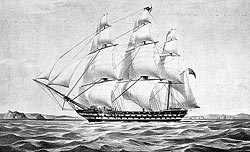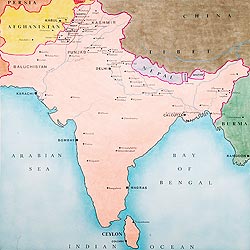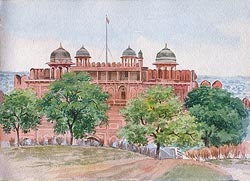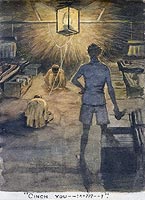Regimental India
1825-1947
 |
| The East Indiaman The Earl Balcarras (Click to enlarge) |
This is a description of the service in India of the three regiments of Foot which became the county regiments of Surrey. It dwells mainly on the period before regimental journals provided an outlet for personal reminiscences. It begins in 1825 when the 2nd Queen’s Royal and the 31st Regiments arrived in India. It was a coincidence that they reached the sub-continent on the same day, the 7th June, the one at Bombay and the other at Calcutta. It had been an uneventful voyage for the Queen’s, but one of the two ships carrying the 31st Regiment sank during a storm in the Bay of Biscay and the survivors rejoined the regiment many months later. The third regiment, the 70th Foot, did not go to India until 1849 after the first two had returned to England. Nevertheless elements of one or other of the three of them were stationed in India for practically all the years until political independence and partition into the states of Pakistan and India in 1947.
Warning orders for India were received in 1824. Both regiments were then serving in Ireland. The Queen’s and the 2/31st had served with great distinction in Portugal and Spain during the Peninsula War, and had reached Toulouse in southern France in 1814 when the campaign came to an end. From there the Queen’s were sent to the West Indies where they suffered greatly from dysentery and yellow fever before moving to Ireland in 1822. The 2/31st returned to England in 1814 and in keeping with other second battalions was disbanded. The1/31st was in Naples in 1814 from where the regiment moved to Malta in 1816 and back to England in 1818 where it was stationed in the industrial Midlands before it also moved
 |
| (Click to enlarge) |
There had been some improvement in soldiers’ conditions of service during the war, but they still remained poorly paid and accommodated. Pensions had been introduced, payable on completion of twenty one years service or on discharge due to disability. Pay had doubled, but mandatory stoppages imposed in respect of messing and the maintenance of uniform and accessories increased proportionally. Barracks were built but the need for billeting continued as units needed to be widely dispersed in small detachments in order to meet law and order requirements in the absence of police forces. Barrack accommodation was sparse and crowded. Wooden cribs were shared for sleeping. It was not until 1827 that it was announced in Parliament that soldiers all over the world had been issued with single bedsteads which, it was explained was “a great ”
Feeding the troops was a Treasury responsibility implemented by the civilian clerks of the Commissariat and meals were limited to two a day, at breakfast and midday. Treasury contractors sold rough liquor in the canteen and took the profits. Flogging was the main punishment. It reflected a savage and obsolete civil code, but many officers disliked it and some contrived to do without it. The Commander-in-Chief, The Duke of York, who was regarded as the soldiers’ friend, had back in 1812 directed that regimental courts martial were not to award more than three hundred
 |
| (Click to enlarge) |
Not a great deal was known about India. Lieutenant John Greenwood of the 31st Regiment wrote in his memoirs that even those families living in England who had relatives in the service of the East India Company tended to suppose that “their chief employment was riding in a palanquin, eating curry and smoking a hookah”. Nevertheless there was the exhilaration of detachments coming together, of fuller regimental life, of talk of better living conditions and the mystery of a far off land ahead of them. There was also relief for some soldiers who had married without their commanding officer’s permission. When that was forthcoming the wife was taken on the strength and provision was made for her and their children to accompany the soldier. The official limit was generally ten per cent of establishment but for India
 |
| (Click to enlarge) |
Officers’ pay remained very low, but the Duke did much to improve their quality and professionalism. The Royal Military College for cavalry and infantry cadets opened at Marlow in 1802 and moved to Sandhurst in 1812. It contained a senior division for the training of selected officers in staff duties which later became the Staff College at Camberley. The Duke introduced a system of confidential reports for the assessment of candidates for commissions and promotion. He also ruled that commissions could not be held under the age of sixteen, and that promotion could not be purchased until the officer had spent a period in the preceding rank. But he was unable to persuade the Government to meet the cost of abandoning the purchase of commissions and promotion by purchase, which remained
The would-be officer needed enough capital to invest in the purchase of a commission. He then had to find a regiment prepared to have him, and where there was a vacancy on its establishment. He could hold the commission until he died although when he was not required for active service he received only half pay, which was important as there was no provision for officers’ pensions. He could sell his commission and regain his capital, but if he died before he had done so the commission reverted to the regiment to be re-allocated as it wished at no cost to the recipient. The so-called deathbed vacancy provided the opportunity to commission deserving soldiers who could not otherwise afford to purchase commissions and to enable deserving officers to obtain advancement when they could not afford to purchase higher rank. There was also the occasional award of brevet promotion to achieve the same purpose.
Related
